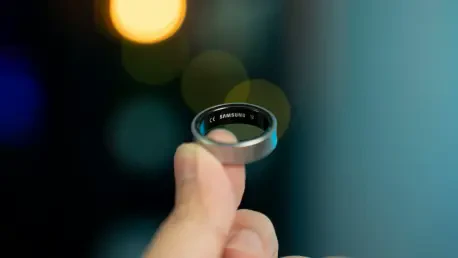As technology becomes an increasingly integral part of personal health management, smart rings have emerged as a transformative innovation in the realm of wearable technology. Unlike traditional smartwatches, smart rings offer a more discreet and convenient way to monitor various health parameters. By being less obtrusive and delivering a comparable suite of features, these rings are changing how people engage with their health and overall wellness. Their compact form factor, coupled with extended battery life, provides significant advantages over bulkier devices, particularly in the realm of seamless, round-the-clock tracking without constant recharging interruptions. This article delves into the evolution and market dynamics of smart rings in 2025, highlighting key players and emerging trends.
Dominance of the Oura Ring
The Oura Ring 4 has carved out a formidable position in the market, widely regarded for its sophisticated approach to health tracking and data visualization. Rather than merely collecting data, it excels at providing users with actionable insights that are easy to visualize and comprehend. This ability to make data relatable is pivotal, as it empowers users to engage more meaningfully with their health statistics. A standout feature of the Oura Ring is its ability to contextualize health metrics; instead of just displaying raw data, the device offers practical advice rooted in the collected information, guiding users toward achieving better health outcomes. For instance, it analyzes sleep patterns with precision and not only reports on them but also provides tips for improvement based on these metrics.
This multifaceted functionality has made the Oura Ring 4 particularly popular among health-conscious individuals seeking a comprehensive understanding of their body dynamics. Its seamless integration of technology and health data representation marks a clear departure from other gadgets that focus solely on measurement without the narrative or feedback loop necessary for genuine behavior change. While leading in the spectrum of smart rings, its premium pricing and subscription model are noteworthy factors that influence consumer decisions, positioning it as both a luxury and an investment in one’s health journey.
New Players in the Market
Despite the Oura Ring’s stronghold, new and dynamic competitors are emerging on the scene, each bringing distinct features that challenge the status quo of health tracking technology. The Samsung Galaxy Ring is a noteworthy entrant, marking Samsung’s first foray into the smart ring arena. This device distinguishes itself by integrating deeply into the Samsung Health ecosystem, broadening its functionality and appeal. A fascinating feature is its capability to capture photos through simple gesture controls, providing a novel and interactive user experience. This gesture-based interaction highlights Samsung’s commitment to innovation, appealing strongly to tech-savvy users and expanding its utility beyond conventional health tracking.
Another significant player is the Ultrahuman Ring Air, which specifically targets fitness enthusiasts with its rich suite of fitness-oriented features. It caters particularly to those who embrace biohacking and seek tools that can provide granular insights into their fitness regime. Offering detailed tracking capabilities, it serves a niche market that seeks to optimize health routines and performance. RingConn Gen 2 Air also enters the mix, presenting itself as a viable option for first-time smart ring users. It emphasizes accessibility and affordability, distinguishing itself with a price model that does not require subscription fees. This makes it an attractive option for those entering the smart ring market, appealing with both its cost-effectiveness and sufficient functionality for health tracking newcomers. Together, these new players are enriching the market, giving consumers a wider array of choices tailored to different lifestyle needs and preferences.
Affordability and Accessibility
The landscape of smart rings in 2025 is marked by a diverse price range, reflecting varied consumer needs and budget considerations. At the higher end of the spectrum lies the Oura Ring, known not only for its advanced tracking capabilities but also for its comparatively high cost, which includes ongoing fees tied to its subscription-based service. For many potential users, this premium pricing model necessitates a careful evaluation of its added value versus its financial commitment. Nonetheless, the Oura Ring continues to attract a loyal customer base willing to invest in its superior health insight offerings.
In contrast, the market also accommodates consumers seeking more budget-friendly options without compromising on core functionalities. The RingConn Gen 2 Air is a quintessential example of this, offering comprehensive health tracking at a fraction of the cost, without imposing recurring subscription fees. Its affordability makes it particularly appealing to price-sensitive consumers and those making their initial foray into health wearables. This accessibility broadens the product’s appeal, allowing more people to engage in health monitoring without a substantial financial outlay.
This range in pricing and accessibility within the smart ring market illustrates a broader trend toward inclusivity and user-centric design. By catering to both ends of the economic spectrum, manufacturers are acknowledging the diverse needs of consumers, providing high-quality health tracking technologies that were once considered luxury items to a wider audience. This approach is instrumental in lowering the barriers to entry for smart rings, ultimately democratizing access to advanced personal health technology.
Robust Health Tracking Features
In 2025, one of the defining characteristics of smart rings is their ability to deliver a comprehensive suite of health tracking features that go beyond basic metrics. These devices are designed to gather a wide range of data, including but not limited to sleep patterns, physical activity levels, heart rate, and even stress indicators. While many rings offer similar capabilities, there remains unanimous consensus that the Oura Ring leads in providing detailed and context-driven data. Its sophisticated algorithms not only collect extensive biometric data but contextualize it, helping users make informed decisions that can improve their long-term health.
The emphasis on actionable data sets the Oura Ring apart, enabling users to understand the implications of their habits on future health outcomes. Other smart rings, though perhaps not as comprehensive in their data analysis, still perform commendably in tracking fundamental health metrics, pushing users toward informed lifestyle choices. By offering insights that influence behavior change, these devices inspire users to take proactive steps toward better health and wellness. The smart rings’ function extends beyond being passive data collectors; they serve a more dynamic role as partners in health, offering pivotal insights that facilitate conscious living adjustments.
Amidst their various functionalities, a common theme among smart rings is the promotion of healthier behaviors. By equipping users with relevant information about their physical and mental states, these devices not only track but also enable self-improvement. Their role is validated not just through high-tech sensors but through the ability to turn raw numbers into visible, real-world health enhancements, highlighting their importance in today’s personal health landscape.
Tailored User Experiences
Smart rings in 2025 are celebrated not only for their advanced technological capabilities but also for their ability to cater to specific user demographics, ensuring that each model resonates with its intended audience. The ability to tailor user experiences to such a fine degree is a pivotal factor in their growing popularity and market adoption. One exemplary case is the Samsung Galaxy Ring, engineered specifically with Android users in mind. It ensures seamless integration with Samsung’s suite of devices, creating a cohesive ecosystem that enhances user convenience and engagement. For Android aficionados, this integration translates into a streamlined user experience, allowing for automatic synchronization and synergy across devices.
Meanwhile, the Ultrahuman Ring Air appeals directly to the burgeoning demographic of fitness enthusiasts who prioritize precise, real-time data to optimize their workouts and training regimens. It stands out by offering features tailored specifically for high-intensity and goal-oriented exercise, making it an indispensable tool for serious athletes and hobbyists alike. This niche targeting ensures that users gain maximum value in areas most relevant to their personal fitness journeys, all while supporting diverse wellness goals.
The emphasis on personalized experiences showcases the adaptability of smart rings to meet varied lifestyle needs. Whether it is the demand for a comprehensive Android integration in the Samsung Galaxy Ring or the fitness-centric capabilities of the Ultrahuman Ring Air, each device’s ability to provide a unique user experience is crucial to its success. This growing focus on customization and user specificity enables smart rings to become more than just a piece of technology; they transform into extensions of personal health decisions, embodying user-centric design philosophies that prioritize individual preferences and requirements.
Continuous Innovation in Wearables
The pace of technological advancement within the smart ring industry underscores a relentless pursuit of innovation, a trend that defines the wearables market of 2025. Continuous improvements and feature enhancements reflect a commitment to addressing user needs more comprehensively and enhancing the overall experience of owning and using a smart ring. This drive for innovation is evident in newer models that incorporate cutting-edge technology, such as stress management tools and biohacking features, illustrating the fusion of health science with digital technology to provide more holistic health insights.
Manufacturers are steadfast in their efforts to introduce functionalities that heighten user engagement and improve health outcomes. This constant evolution is integral in maintaining the interest and trust of users, who are increasingly looking for devices that not only meet current health tracking expectations but anticipate future needs as well. The inclusion of advanced technologies, such as sensors capable of detecting subtle physiological changes, enables smart rings to provide preventative health insights, empowering users to act preemptively on emerging health issues.
By continuing to innovate, smart rings are setting new standards for what wearables can achieve. Their evolution is driven by the desire to make health information more accessible, actionable, and accurate, pushing the boundaries of how personal health technologies are perceived and utilized. This relentless pursuit of innovation not only enriches the user experience but also ensures that as the context of personal health management evolves, smart rings remain at the forefront, championing the integration of cutting-edge tech in daily wellness routines.
Analysis of Market Leaders
Although the Oura Ring has been a dominant force in the health tracking tech market, it’s now facing competition as new contenders emerge, each introducing unique features that challenge the traditional norms. A prime example is the Samsung Galaxy Ring, Samsung’s first venture into the smart ring market. This device stands out by seamlessly integrating with the Samsung Health ecosystem, enhancing both its functionality and attractiveness to users. One of its innovative features is its ability to take photos using simple hand gestures, providing an engaging and interactive experience. This feature showcases Samsung’s dedication to innovation, appealing to tech-savvy consumers and extending beyond basic health tracking.
Another notable competitor is the Ultrahuman Ring Air, which is tailored for fitness enthusiasts. It excels in offering fitness-oriented features, catering to individuals who are into biohacking and desire comprehensive insights into their workouts. With its detailed tracking capabilities, it serves those looking to optimize their health and performance. Additionally, the RingConn Gen 2 Air presents itself as a great option for newcomers to smart rings. It focuses on accessibility and affordability, offering a cost-effective model without subscription fees, appealing to first-time users wanting basic health tracking functionalities. These new entrants broaden the market, offering consumers diverse options to suit various lifestyle needs and preferences.









